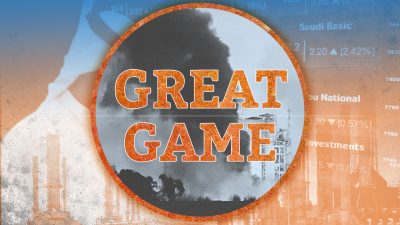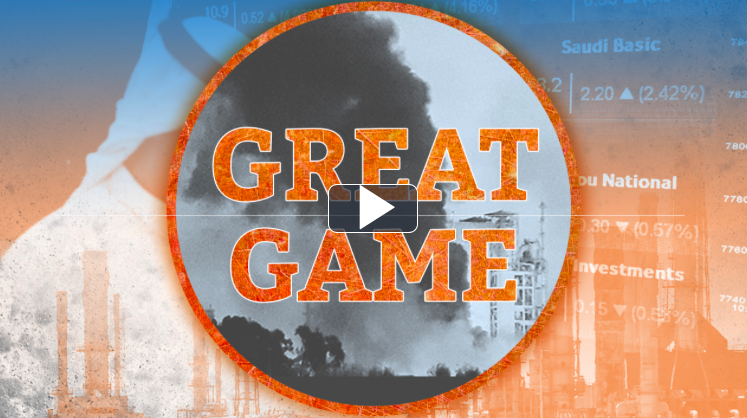Video: Who Really Benefits from The Alleged ‘Iranian Attack’ on Saudi Arabia’s Oil Facility?

In the second half of 2019, the Middle East entered yet another turbulence zone created by a sharpened conflict between Iran and regional Shia groups on the one side and the US-Israeli-Saudi alliance on another. In contrast to the 2015-2017 period, when key players were mainly focusing on Syria and the surrounding part of the region, in 2019 the main point of tensions moved to the Persian Gulf and the Saudi-Yemeni battleground. The situation is marked by increased chances of an open military confrontation between the US-Israeli-Saudi bloc and Iran. Drone shootdowns, oil tanker detentions, open military buildups and wartime-like rhetoric became something common or at least not very surprising.
The US, Saudi Arabia and Israel point at Iran as the main instigator of tensions. US Secretary of State Mike Pompeo even described the recent attack on Saudi oil facilities, attributed by the Washington-led bloc to Iran, as “an act of war”. Iran, in own turn, rejects all the accusations of its supposed involvement calling them “lies” and supports the version provided by Yemen’s Houthis (Ansar Allah). The movement took responsibility for the strike saying that it came, as multiple previous ones, in response to the siege imposed by the Saudi-led coalition on Yemen. Regardless who was behind the recent attack on the Saudi oil infrastructure, the key question is “who would benefit from this new round of escalation?”
The September 14 strike on facilities of Saudi oil giant Aramco in Buqayq and Khurais shut down a half of the Kingdom’s oil output and caused a crisis on the world oil market. Saudi Arabia’s production capacity was reduced by about 5.7 million barrels per day, or 5% of the global oil supply. Brent crude spiked over $70 a barrel and West Texas Intermediate climbed over $60 a barrel. Aramco pledged that production would return to 11 million barrels per day by the end of September causing some decline in oil prices. If the Kingdom appears to be not capable of turning this promise into reality and the situation in the region continues to escalate, oil prices may grow even further reaching $75-80 a barrel.
An open military conflict between the US-led bloc and Iran in the region will have a devastating impact to the global economy even more than the so-called economic war between the US and China. Iran has repeatedly demonstrated that it is capable to close the Strait of Hormuz and disrupt oil trade in the event of the military confrontation in the close proximity to its shores.
However, even if there is no open military conflict, the threat of attacks on oil fields, pipelines, refineries, production plants and other objects infrastructure make Saudi Arabia a potentially unstable oil supplier. According to Nikkei Asian Review, Aramco already notified Japan’s top oil distributor, JXTG Nippon Oil & Energy, about a potential change in shipments in October. The report says that Aramco wants to change the delivered oil grade from light to heavy and medium and suggests that Aramco would need more time than expected to repair its desulfurization facility, which is necessary to produce light-grade crude. This oil grade is used in the production of gasoline and light gas oil. These factors are expected to prevent a further decline of oil prices and force large crude oil buyers to consider diversifying their sources of light-grade crude.
Here, there United States enters the game. In the last decade, it has more than doubled oil production to 12.3 million barrels a day, becoming the world’s largest producer. Right now, the US is finalizing additional infrastructure to transport crude out of Texas oil fields and onto the world market. According to Citigroup, the new pipelines could help grow US oil exports from the current 3 million barrels a day by 1 million barrels more by the end of 2019 and another million barrels in 2020. Some sources suggest that in 2019-2020, the US oil export potential may grow to 4.7 million barrels per day thanks to launches of new pipelines and currently ‘drilled but uncompleted’ shale oil wells (over 8,500 are available now).
Relatively high oil prices would contribute to the economic policy provided by the Trump administration. They remain within the comfort zone of the industrial sector and oil consumers of the US. At the same time, the industry of large oil consumers, like China and Germany, would bear additional costs because of the growth of energy prices. Therefore, the Trump administration would get additional odds in its economic war with China and protectionist policy against the EU industrial states.
Additionally, the September 14 attack and the growth of tensions in the Persian Gulf, in general, gave the Trump administration a formal pretext to increase its activity in the region. The US already announced that it is deploying additional troops and missiles in Saudi Arabia and imposing a new round of sanctions on Iran. If Washington fuels the war-hysteria and further, the Trump administration may even venture upon a deployment of limited military contingent to combat ‘Iranian proxies’ in Yemen or a limited strike on some non-critical ‘Iranian targets’ in the region.
This ‘controlled escalation’ would allow Washington to consolidate existing and gain additional levers of pressure on global energy prices, including the influence on Saudi Arabia, and, therefore, manipulate the global energy market in own interests. A similar motivation stands behind the US geopolitical activity towards Venezuela.
Besides these, the fight against the ‘Iranian threat’ is an important part of Donald Trump’s foreign policy agenda promoted in the framework of the 2020 presidential campaign. This gives his administration additional motivation to support the “Iran attacked Saudi Arabia” narrative.
In own turn, the attack on Saudi oil infrastructure gives little benefits to Iran whose economy, including the energy sector, is already under a strong sanction pressure. The confrontation with an artful foreign enemy helps to consolidate the nation in the face of the sharpening standoff the country’s competitors, but this is a not sufficient motivation. Instead, the constant threat of regional war may impact negatively prospects of the China-Iranian strategic partnership in the energy sphere in the framework of which, Beijing plans to invest $280bn developing Iran’s oil, gas and petrochemicals sectors and another $120bn in upgrading Iran’s transport and manufacturing infrastructure.
As to Russia, another MSM-created bogeyman ‘undermining democracy’ in the Middle East, it, as well as other large oil producers and financers, would get additional revenues thanks to the growth of oil prices in the short-term. Nonetheless, it would be hard for Moscow to get some strategic advantages on this situation.
Meanwhile, Yemen’s Houthis would continue to pursue their main goal – to achieve a victory in the conflict with Saudi Arabia or to force the Kingdom to accept the peace deal on favorable terms. To achieve this, they need to deliver the maximum damage to Saudi Arabia’s economy through strikes on its key military and infrastructure objects. In this case, surprising missile and drone strikes on different targets across Saudi Arabia have already demonstrated their effectiveness. If the Houthis continue to act in a similar audacious and considered manner, there are high chances that the September 14 attack was only the first sign of future challenges that Riyadh would face in this conflict.
*
Note to readers: please click the share buttons above or below. Forward this article to your email lists. Crosspost on your blog site, internet forums. etc.
Support South Front in its endeavors.
If you’re able, and if you like our content and approach, please support the project. Our work wouldn’t be possible without your help: PayPal: [email protected] or via: http://southfront.org/donate/ or via: https://www.patreon.com/southfront


